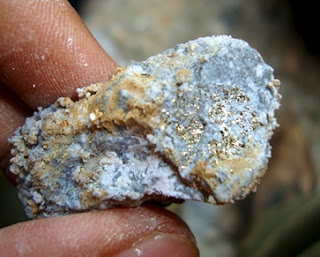People often think phyrite as a golden appearance, which resembles gold glitter. Occasionally someone asks, if pyrite is gold? Or is this auriferous pyrite??? Indeed, often times the physical appearance of the mineral pyrite is almost like a mineral ore of gold, maybe some people who never see it will think that the mineral pyrite is gold metal. Physical appearance is almost similar to the gold ore PHYRITE, markasit, and chalcopyrite seen from the color, but can be distinguished from its soft, high density, and golden appearance. Gold associated with quartz, phyrite, arsenopyrite, and Silver. The physical properties of gold is very stable, not corrosive or weathered and rarely had a compound with other chemical elements. Electrical and thermal conductivity is very good, malleable so it can be formed and also be ductile. Gold is the most high-density metals.
Pyrite with the chemical formula FeS2, is one of the types of sulphide minerals which are common in nature, as a byproduct of a hydrothermal deposits or as accessory minerals in some rock types. Descriptively, pyrite has a golden yellow color with metallic sheen.Crystal structure of pyrite and gold are both cabbage, but the nature of it that are different. Gold is more malleable than pyrite. If beaten, pyrite will shatter, whereas gold is not easily destroyed because they are more malleable.
A fairly easy way to distinguish the gold with pyrite is to hone his side look under a microscope.Usually under a microscope reflective, irregularly shaped gold look that is sometimes compared to pyrite cube shape is still visible.Although both isotropic, but the brilliance of gold can not be matched by pyrite, as well as shape.Another way is to analyze the chemical content, such as by EDX microprobe or SEM plus, in this way can be distinguished from pyrite or gold.
A fairly easy way to distinguish the gold with pyrite is to hone his side look under a microscope.Usually under a microscope reflective, irregularly shaped gold look that is sometimes compared to pyrite cube shape is still visible.Although both isotropic, but the brilliance of gold can not be matched by pyrite, as well as shape.Another way is to analyze the chemical content, such as by EDX microprobe or SEM plus, in this way can be distinguished from pyrite or gold.
Because gold can be associated with pyrite, it is possible there is gold in pyrite, which is known as refractory gold. Gold is usually present together arsenic (arsenian pyrite or arsenopyrite)Gold is metallic minerals of high value both in terms of price and the use side. The metal is also the first metal mined because it is often found in pure metallic form. These minerals are often grouped into precious metals (precious metal).In geochemistry, gold is an element of siderophile (iron-like), and a little chalcophile (would like sulfur). Because of its much gold is then bonded with iron or minerals stable in the buffer of iron (magnetite / hematite). In nature the biggest gold resources is at the core of the earth, because the content of the earth's core is ~ 100% iron, with a slightly lighter elements, such as sulfur, silicon and oxygen.
Gold can be found naturally in some minerals, such as pure gold, silvanit, kalaverit, krenerit, nagyagit, electrum, and uytenbogaardtit. Pure gold (native gold) contains about 20-20% silver and 0.1-0.5% copper. Electrum is gold containing 30-50% silver. Based on the results of geochemical analysis, the average gold content in the earth's surface (crust) of 0.002 g / t (grams per tonne). Gold has an atomic number 79 and the chemical name Aurum or Au. Group elements including native gold, with little content of silver, copper, or iron. The color is golden yellow with a Mohs hardness 2.5 to 3 scale. Isometric crystal form octahedron or dodecahedron. The specific gravity of 15.5 to 19.3 in pure gold. The larger the silver content, the more whitish.
- A reservoir containing the gold even though the levels are not so great,
- Hot water solution that can bring gold to the trapping, and place of entrapment.
Gold can be found in large enough quantities at the core of the earth and rocks the size of smooth, like a black clay.Two of these are potential reservoirs of this golden metal.Transfer of gold from the reservoir to the surface of the earth required the carrier, in this case a solution of hot water (hydrothermal solution). In addition there must be a metal that can cause the gold can be dissolved into hydrothermal solution, for example a solution of the complex sulphide, chloride complex solution and a solution of complex tio..In the process of geochemistry, gold can usually be transported in the form of complex sulphide or chloride solution.The process of transporting the gold can be seen in the following reaction:
[Au(HS)2]- + H+ + 1/2 H2O = Au0 + 2H2S + 1/4O2
From this reaction can be seen that the deposition of gold is very dependent on the magnitude of changes in pH, H2S, oxidation, boiling, cooling, and adsorption by other minerals. For example, the gold will sink if the situation changes slightly alkaline and of reduction to oxidation. Or the gold will precipitate if bound to other minerals such as pyrite.
Pure gold is very easily soluble in KCN, NaCN, and Hg (mercury). So that gold can be extracted from minerals fastening through amalgamation (Hg) or by using a solution of cyanide (NaCN usually) with activated carbon. In between these two methods, the method of amalgamation is most easily done and relatively low cost. Only with a capital of mercury and burners, gold can easily be retrieved from the straps. This method is generally used by local residents to take the gold from the rock carrier.





